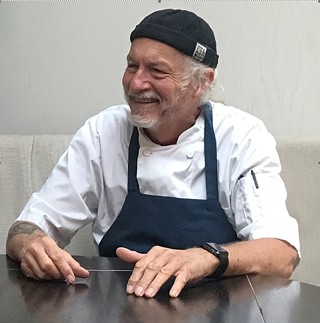Easter on a spit
[
{
"name": "Air - MedRect Combo - Inline Content 1",
"component": "11490391",
"insertPoint": "3",
"requiredCountToDisplay": "1",
"parentWrapperClass": "fdn-ads-inline-content-block"
},{
"name": "Air - MedRect Combo - Inline Content 2",
"component": "11490392",
"insertPoint": "7",
"requiredCountToDisplay": "5",
"parentWrapperClass": "fdn-ads-inline-content-block"
},{
"name": "Air - MedRect Combo - Inline Content 3",
"component": "11490393",
"insertPoint": "12",
"requiredCountToDisplay": "9",
"parentWrapperClass": "fdn-ads-inline-content-block"
}
]
At the south end of the land that is now Panther Creek Country Club sits the historic 1860 Spaulding Orchard farmhouse, my home for the last 35 years. What was once one of Illinois’ largest apple orchards and asparagus farms is now stately houses and rolling fairways. All that remains of Spaulding Orchard is a few barns and my farmhouse.
The house is surrounded by two and a half acres of woods and wildflower meadows, which had been lovingly tended by my late wife Julianne. I credit my wife because many years ago, when the late spring grass was nearly ankle high, she fired me from doing any yard work after I mowed down her wildflowers. I was riding the lawn tractor, listening to music on my Walkman when I saw her frantically running towards me with angry eyes and flailing arms. My first thought was that one of the children had fallen down the stairs or scalded themselves with boiling water (both had actually happened once before). I pulled off my earphones and shut down the mower. “You are mowing down the wild larkspur!” she was screaming. My dispassionate, expletive-laced response got me banned from mowing duty forever.
Over the years, whenever I brought up the possibility of someday selling the house and relocating to a warmer climate, Julianne steadfastly refused to entertain that notion. Her emotional connection to the land was strong.
Each winter’s long-awaited departure was heralded by the emergence of the first spring blooms in sunny, warm spots around the house. Daffodils, tulips, spring beauties, fiddleheads, ramps and violets soon followed the snowdrops and crocuses she had transplanted from her grandmother’s house. The view outside our windows took on the appearance of a Monet landscape. The magic accompanying the change of the seasons was never more spectacular than when warm weather and Easter coincided.
We have hosted Easter egg hunts every year we have lived at the Spaulding Orchard Farmhouse. This year’s event will be the last because I have decided to put the house on the market.
Our family’s Easter celebration always begins with a Saturday evening bonfire and wiener roast followed by egg dying and decoration. We typically dye 12 dozen eggs.
Some years the Easter egg hunt has been a chilly damp affair, but the only ones who seemed to mind were the adults.
When my wife was alive she was definitely the matriarch of the kitchen. She ruled the roost and controlled the menu. Because her knowledge, skill and experience exceeded mine, and because she was a messy cook who hated washing dishes, I spent my holidays with my hands in dishwater.
I figured out that the only way I could get a reprieve from dishwashing was to announce that I had planned a special surprise for the holiday meal – a secret I could not reveal. The Christmas meal was sacrosanct, but I had a little wiggle room with Easter.
One year when the spring wildflowers were at peak splendor, I dragged the dining table and chairs deep into the woods across the road alongside a flowing creek and marked the path with Easter eggs.
I cooked Easter brunch over an open fire. It was a breathtakingly beautiful meal. However it took me all Sunday afternoon to drag the furniture and dirty dishes back into the house afterwards. I still ended up washing dishes.
One year my Easter surprise was to roast a whole lamb on a turning spit over coals in the Greek Orthodox style. After asking around at gyros restaurants, I discovered Hristos Lalopoulos, owner of XL Manufacturing, in a Greek neighborhood in Chicago. He is the manufacturer of the automatic gyros roasters you see in most gyros joints. He also manufactures steel rotisseries and the electric motors that turn the spit.
On a cold, grey March weekend I drove to Chicago to buy my lamb roaster. Hristos, who goes by Chris, is a large bearded Greek guy with a booming voice and a thick accent. He asked me how big a lamb I was planning on cooking. I shrugged and held out my hands. This big, I gestured: “25 pounds or so.” (To be honest, I had never cooked lamb any bigger than a lamb chop.) He showed me an appropriately sized unit, about four feet wide on four legs about three feet tall.
I asked him for pointers on roasting my little beast: “A little salt, a little garlic, olive oil, lemon, BUT NO OREGANO!” He was emphatic about the oregano.
I had driven up in a Nissan Sentra and soon realized that my new roaster would not fit into the trunk or back seat so I went off in search of a roll of duct tape and used the whole roll to bind the roaster, legs pointing up, to the roof of the car, wrapping around the roof and through the back seat windows.
My sister lived in Chicago near the meatpacking district so I invited her family to spend Easter with us and bring down a lamb. When they arrived, I anxiously peered into their trunk. Underneath a big bag of ice, in a clear plastic bag was my not-so-little lamb with his not-so-little head intact. My children shrieked. It freaked me out as well.
I wrestled my lamb out of the trunk and carried him over to the foil-covered plywood table I had set up by the roaster. I studied the scene for a while, took some measurements and decided the head needed to go. My brother-in-law chimed in: “The butcher said the head was tasty, especially the cheeks.” “So I’ll save it and put it in the freezer”, I replied.
My first thought was to get my chainsaw, but I feared the meat would taste like petroleum fumes, so I settled on decapitating my lamb with my hacksaw.
By this point, between the roaster and the lamb, I had more than $600 invested in my Easter surprise and everybody was losing their appetites. I impaled the lamb with the spit through its rear entrance and out through the severed neck. As the lamb started turning, the weight of the sagging belly was keeping the lamb stationery while the spit rolled around inside. I found my bag of wire ties and bound him tightly to the spit.
Soon I realized I had forgotten to ask Chris how long it would take to cook. After five hours, the meat thermometer told me that the lamb was ready. The sun was getting low in the sky. Being a Sunday, most of the guests had departed.
I let the lamb rest and cut him up. The meat was succulent and was enjoyed by the few who remained. The leftovers were packed and put into the freezer.
And alas, I still ended up having to do the dishes.
Postscript: I found my lamb’s head last summer during my freezer cleanout.
Contact Peter Glatz at [email protected].
The house is surrounded by two and a half acres of woods and wildflower meadows, which had been lovingly tended by my late wife Julianne. I credit my wife because many years ago, when the late spring grass was nearly ankle high, she fired me from doing any yard work after I mowed down her wildflowers. I was riding the lawn tractor, listening to music on my Walkman when I saw her frantically running towards me with angry eyes and flailing arms. My first thought was that one of the children had fallen down the stairs or scalded themselves with boiling water (both had actually happened once before). I pulled off my earphones and shut down the mower. “You are mowing down the wild larkspur!” she was screaming. My dispassionate, expletive-laced response got me banned from mowing duty forever.
Over the years, whenever I brought up the possibility of someday selling the house and relocating to a warmer climate, Julianne steadfastly refused to entertain that notion. Her emotional connection to the land was strong.
Each winter’s long-awaited departure was heralded by the emergence of the first spring blooms in sunny, warm spots around the house. Daffodils, tulips, spring beauties, fiddleheads, ramps and violets soon followed the snowdrops and crocuses she had transplanted from her grandmother’s house. The view outside our windows took on the appearance of a Monet landscape. The magic accompanying the change of the seasons was never more spectacular than when warm weather and Easter coincided.
We have hosted Easter egg hunts every year we have lived at the Spaulding Orchard Farmhouse. This year’s event will be the last because I have decided to put the house on the market.
Our family’s Easter celebration always begins with a Saturday evening bonfire and wiener roast followed by egg dying and decoration. We typically dye 12 dozen eggs.
Some years the Easter egg hunt has been a chilly damp affair, but the only ones who seemed to mind were the adults.
When my wife was alive she was definitely the matriarch of the kitchen. She ruled the roost and controlled the menu. Because her knowledge, skill and experience exceeded mine, and because she was a messy cook who hated washing dishes, I spent my holidays with my hands in dishwater.
I figured out that the only way I could get a reprieve from dishwashing was to announce that I had planned a special surprise for the holiday meal – a secret I could not reveal. The Christmas meal was sacrosanct, but I had a little wiggle room with Easter.
One year when the spring wildflowers were at peak splendor, I dragged the dining table and chairs deep into the woods across the road alongside a flowing creek and marked the path with Easter eggs.
I cooked Easter brunch over an open fire. It was a breathtakingly beautiful meal. However it took me all Sunday afternoon to drag the furniture and dirty dishes back into the house afterwards. I still ended up washing dishes.
One year my Easter surprise was to roast a whole lamb on a turning spit over coals in the Greek Orthodox style. After asking around at gyros restaurants, I discovered Hristos Lalopoulos, owner of XL Manufacturing, in a Greek neighborhood in Chicago. He is the manufacturer of the automatic gyros roasters you see in most gyros joints. He also manufactures steel rotisseries and the electric motors that turn the spit.
On a cold, grey March weekend I drove to Chicago to buy my lamb roaster. Hristos, who goes by Chris, is a large bearded Greek guy with a booming voice and a thick accent. He asked me how big a lamb I was planning on cooking. I shrugged and held out my hands. This big, I gestured: “25 pounds or so.” (To be honest, I had never cooked lamb any bigger than a lamb chop.) He showed me an appropriately sized unit, about four feet wide on four legs about three feet tall.
I asked him for pointers on roasting my little beast: “A little salt, a little garlic, olive oil, lemon, BUT NO OREGANO!” He was emphatic about the oregano.
I had driven up in a Nissan Sentra and soon realized that my new roaster would not fit into the trunk or back seat so I went off in search of a roll of duct tape and used the whole roll to bind the roaster, legs pointing up, to the roof of the car, wrapping around the roof and through the back seat windows.
My sister lived in Chicago near the meatpacking district so I invited her family to spend Easter with us and bring down a lamb. When they arrived, I anxiously peered into their trunk. Underneath a big bag of ice, in a clear plastic bag was my not-so-little lamb with his not-so-little head intact. My children shrieked. It freaked me out as well.
I wrestled my lamb out of the trunk and carried him over to the foil-covered plywood table I had set up by the roaster. I studied the scene for a while, took some measurements and decided the head needed to go. My brother-in-law chimed in: “The butcher said the head was tasty, especially the cheeks.” “So I’ll save it and put it in the freezer”, I replied.
My first thought was to get my chainsaw, but I feared the meat would taste like petroleum fumes, so I settled on decapitating my lamb with my hacksaw.
By this point, between the roaster and the lamb, I had more than $600 invested in my Easter surprise and everybody was losing their appetites. I impaled the lamb with the spit through its rear entrance and out through the severed neck. As the lamb started turning, the weight of the sagging belly was keeping the lamb stationery while the spit rolled around inside. I found my bag of wire ties and bound him tightly to the spit.
Soon I realized I had forgotten to ask Chris how long it would take to cook. After five hours, the meat thermometer told me that the lamb was ready. The sun was getting low in the sky. Being a Sunday, most of the guests had departed.
I let the lamb rest and cut him up. The meat was succulent and was enjoyed by the few who remained. The leftovers were packed and put into the freezer.
And alas, I still ended up having to do the dishes.
Postscript: I found my lamb’s head last summer during my freezer cleanout.
Contact Peter Glatz at [email protected].
Illinois Times has provided readers with independent journalism for almost 50 years, from news and politics to arts and culture.
Your support will help cover the costs of editorial content published each week. Without local news organizations, we would be less informed about the issues that affect our community..
Got something to say?
Send a letter to the editor and we'll publish your feedback in print!


















